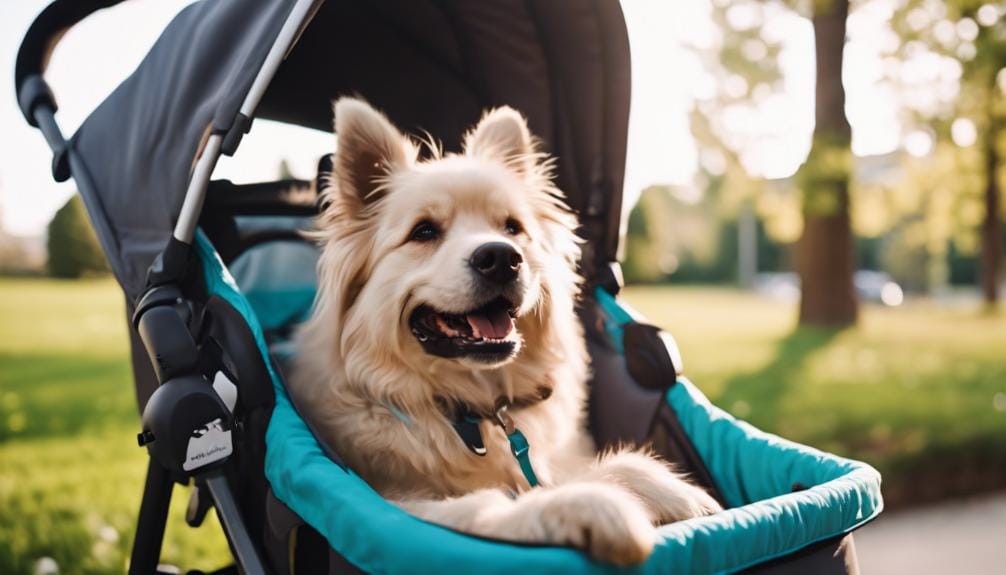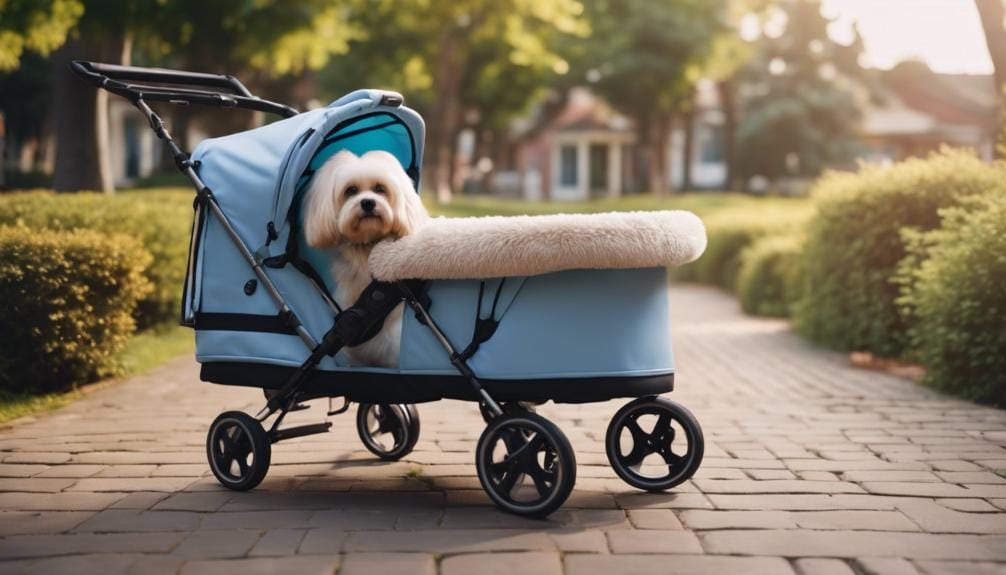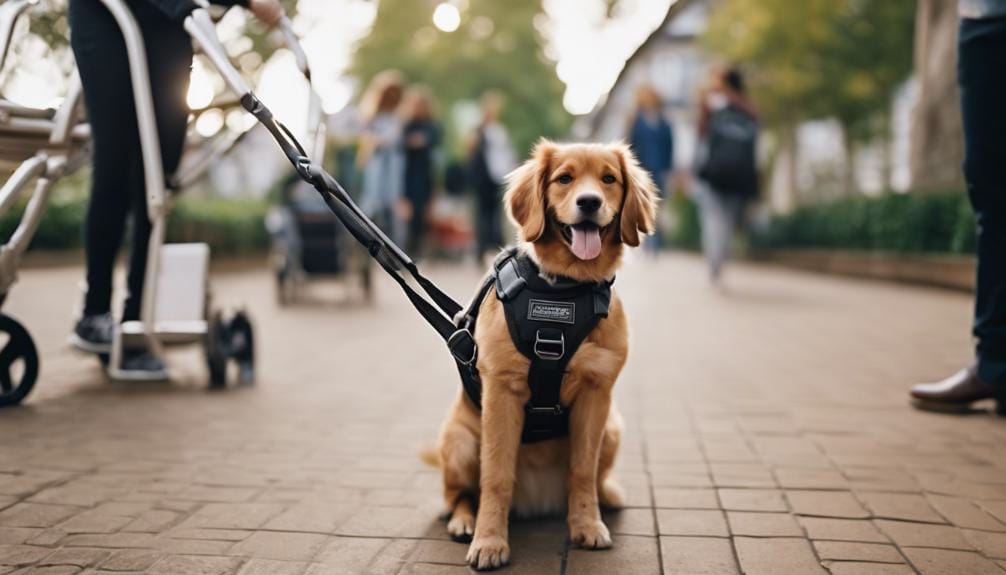Imagine the stroller as a safe haven, a cozy retreat for your furry companion. Getting your dog used to a stroller requires patience and positive reinforcement. From the initial introduction to securing them comfortably, each step plays an essential role in acclimating your dog to this new experience.
By following a structured approach and being consistent with training, you can help your dog feel at ease and even enjoy the stroller outings.
But what happens when your dog shows resistance or fear towards the stroller?
Key Takeaways
- Familiarize your dog gradually with the stroller in a positive way.
- Reward good behavior with treats and praise to create a positive association.
- Introduce movement slowly, monitoring your dog’s comfort and using positive reinforcement.
- Secure your dog properly in the stroller and transition to longer adventures gradually.
Familiarizing Your Dog With the Stroller
To ease your dog’s change to the stroller, gradually introduce them to it in a familiar setting where they feel comfortable and at ease. Start by leaving the dog stroller open in a space your dog frequents, allowing them to investigate it at their own pace. Encourage positive associations by using treats or toys, rewarding your dog for approaching or sniffing the stroller. This helps create a link between the stroller and positive experiences.
As your dog becomes more familiar with the stroller, begin introducing movement. Gently push the stroller back and forth while your dog is nearby, showing them that it’s nothing to fear. Allow your dog to hop in and out of the stroller voluntarily, reinforcing calm behavior with praise and treats. This voluntary interaction helps build trust and confidence.
Consistency is key in this process. Repeat the steps regularly, gradually increasing the time spent near and in the stroller. The goal is to make the stroller a normal part of your dog’s environment, ensuring they’re comfortable and at ease when it comes time to use it for outings. By taking it slow and building positive associations, your dog will soon see the stroller as a safe and familiar place.
Rewarding Positive Behavior Early

As your dog displays interest in the stroller, start rewarding their positive behavior early to establish a strong foundation for comfortable interactions with this new equipment. Here are some tips to help you reward your dog’s positive behavior around the stroller:
- Use Treats: Treats are a powerful motivator for dogs. When your dog shows curiosity towards the stroller or behaves calmly around it, offer a tasty treat to reinforce this positive behavior.
- Provide Verbal Praise: Along with treats, verbal praise can go a long way in encouraging good behavior. Use a happy tone of voice to let your dog know they’re doing the right thing.
- Create Positive Associations: By rewarding early interactions with the stroller, you’re helping your dog associate this new object with positive experiences. This will make them more comfortable around it in the long run.
- Consistent Reinforcement: Consistency is key in training. Make sure to reward your dog every time they display positive behavior around the stroller. This will reinforce the desired actions and help your dog become more at ease with the stroller.
Gradual Introduction to Movement

When introducing movement to your dog’s stroller experience, start by wheeling the stroller around slowly to familiarize them with the motion. Allow your dog to observe the stroller in motion from a safe distance initially. This will help them become comfortable with the movement before actually getting in. Using positive reinforcement, such as treats, will create a positive association with the stroller’s movement.
As your dog starts to adjust, gradually increase the pace and distance of the stroller’s movement. This gradual introduction will help your dog feel more at ease with the changing speeds and distances. Remember to monitor your dog’s body language and comfort level throughout the process. If they seem stressed or uncomfortable, slow down the pace or take a break to reassess.
Securing Your Dog in the Stroller

Consider using a back-clip harness to guarantee your dog’s safety and prevent choking when securing them in the stroller. Here are some tips to help you secure your dog in the stroller effectively:
- Choose the Right Stroller: Opt for a pet stroller with a covering if your dog tends to jump out during rides. This extra layer of security can prevent any unexpected escapes.
- Properly Secure the Leash: Make sure the leash is firmly fastened to the stroller to prevent your dog from escaping. A sturdy leash attachment will keep your dog safe and close by.
- Ensure Comfort and Safety: Fasten your dog securely within the stroller to guarantee their comfort and safety during the ride. Double-check the fastenings to avoid any accidents or discomfort.
- Gradually Increase Distance: To help your dog acclimate to longer rides in the stroller, gradually increase the distance you push them. This gradual approach can help your dog feel more at ease and enjoy the outings more.
Transitioning to Longer Stroller Adventures

Prepare your dog for longer stroller adventures by gradually increasing the duration of your outings, monitoring their comfort and behavior throughout. Start by extending your stroller walks by a few minutes each time, paying attention to how your dog responds. Look for signs of discomfort or fatigue, such as lagging behind, excessive panting, or trying to jump out of the stroller. If your dog seems uneasy, shorten the outing and try again the next day.
During extended stroller outings, make sure to offer your dog water breaks to keep them hydrated and energized. Consider bringing along a portable water bowl and a supply of fresh water. Additionally, provide your dog with opportunities to take short breaks to stretch their legs and explore their surroundings.
Use positive reinforcement and rewards to encourage good behavior during longer stroller trips. Praise your dog for staying calm and relaxed in the stroller, and offer treats as a reward. This will help create a positive association with the stroller and make the experience more enjoyable for your furry friend.
As you change to longer stroller adventures, gradually introduce your dog to new environments and distractions. Start in familiar surroundings and slowly venture into more diverse locations. This will help acclimate your dog to different sights, sounds, and smells, making them more comfortable during stroller outings in varied settings.
Frequently Asked Questions
Do Dogs Like to Ride in Strollers?
Dogs’ preferences for stroller rides vary; some enjoy the comfort and security they provide, while others may need time to adjust. Consider your dog’s comfort and gradually introduce them to stroller rides for positive associations.
How Do You Train a Dog to Walk in a Stroller?
To train a dog to walk in a stroller, start by creating a positive association with the stroller using treats and praise. Gradually increase the duration and distance of rides while ensuring the stroller is secure and your dog feels comfortable.
How Do I Get My Puppy to Like the Stroller?
To get your puppy to like the stroller, start by creating positive associations through treats and toys. Let them explore it at their pace, rewarding calm behavior. Gradually introduce sitting in it with comfort items and practice short walks indoors before venturing outside.
How Do You Keep a Dog in a Stroller?
To keep a dog in a stroller, secure them with a back-clip harness, attach the leash properly, choose a stroller with a covering, and guarantee comfort. Gradually increase the distance of rides to acclimate your dog.
Conclusion
To sum up, getting your dog used to a stroller takes time, patience, and positive reinforcement. By gradually introducing the stroller, rewarding good behavior, and practicing with short trips, you can help your furry friend feel comfortable and secure in their new ride.
Remember to always make the experience enjoyable for your dog and celebrate their progress as they become more accustomed to using the stroller.
Happy strolling!





Leave a Reply
You must be logged in to post a comment.